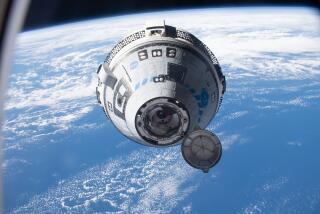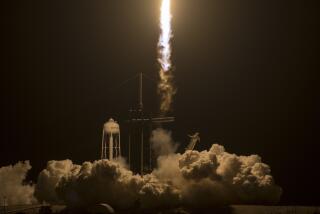Glitch in Communications Delays Shuttle’s Launch of Space Laboratory : Science: Flight controllers express confidence about next attempt after the problem vanishes. Tethered-satellite test is also postponed.
KENNEDY SPACE CENTER, Fla. — A communications gremlin sabotaged the launching of a $213-million European laboratory from the space shuttle Atlantis early Saturday, frustrating what was supposed to have been the easy part of a demanding week in orbit.
Prevented from determining whether the laboratory was ready for free flight, officials of the European Space Agency and the National Aeronautics and Space Administration postponed its planned release until early today.
After monitoring the lab throughout the day and again testing the communications link that had caused the delay, NASA reported that the problem appeared to have vanished.
Flight controllers set another attempt at releasing the payload for shortly after midnight PDT.
Atlantis’ path around Earth would provide a launch opportunity on six consecutive orbits over a period of nine hours, Mission Control reported late Saturday.
The chief impact of the daylong delay was to force a 24-hour postponement of a much-anticipated experiment at generating electricity in space using a satellite tethered to the shuttle on a 12 1/2-mile-long cord.
But it also raised the possibility that the seven astronauts aboard the shuttle would be asked to stretch their fuel supplies and fly an additional day to complete their long list of assignments.
Officials expressed confidence, however, that they would be able to launch the 9,000-pound European laboratory on their second try.
“I have no doubt that we will solve the problem,” flight controller Phil Engelauf told reporters at the Johnson Space Center in Houston.
The hang-up was caused by a mysterious breakdown in communications between the micro-gravity laboratory and the shuttle during preparations for release of the payload.
Once the laboratory is deployed from Atlantis, communications will be carried out through ESA stations in Germany, the Canary Islands and French Guiana.
However, because brief passes over the ground stations on Friday night did not provide enough time to thoroughly check the laboratory, the mission plan called for that task to be performed by the shuttle crew.
But shortly after the lab was hoisted from the cargo bay in preparation for release, there were intermittent lapses in the stream of data transmitted to the shuttle for relay to Earth.
Data sent directly to ground stations from the laboratory as the orbiter passed within range indicated that all was well within the facility. But ESA officials insisted on knowing its readiness with a certainty possible only through extensive information collected and relayed by the shuttle.
After several hours of frustration--and still not understanding the lapses--ESA flight controllers huddled in Darmstadt, Germany, and ordered the release postponed for another 12 hours.
The lab--called EURECA, for European Retrievable Carrier, is due to operate for six to nine months before being picked up and returned to Earth by another shuttle crew.
Seven separate compartments house more than a dozen experiments, which will be controlled by commands from the ESA Control Center at Darmstadt.
Because the carrier flies free and without disturbance from astronauts’ movements or orbital maneuvers, the experiments aboard will be subject to only a tiny fraction of the Earth’s normal gravity.
Once Saturday’s launch attempt was abandoned, Atlantis’ astronauts swung the lab into a “parked” position just above the shuttle’s open bay, leaving it attached to the remote-control cargo handling arm.
Its 20-foot solar panels, unfolded after it was lifted out of the bay early Saturday, remained open.
In Germany and in Houston, engineers spent the rest of the day monitoring the laboratory and convinced themselves that it was operating flawlessly.
Mission specialists Marsha Ivins, Jeff Hoffman and Franklin Chang-Diaz spent much of the day, meanwhile, checking out the tethered satellite, due to be released Tuesday under the crew’s revised schedule.
Marine Maj. Andrew Allen, the Atlantis pilot, mission specialist Claude Nicollier from Switzerland, and Italian astronaut Franco Malerba spent most of the day sleeping because they had worked through the night Friday preparing for the launch attempt that was scrubbed.
They returned to work Saturday afternoon to prepare for the second attempt. Air Force Col. Lauren J. Shriver, the mission commander, also planned to be on duty.
The balky communications link was as surprising as it was disappointing because the lab and the shuttle had communicated successfully in ground tests conducted in Houston and on the launch pad in Florida.
And given past successes at satellite launches by the shuttle, the release had been expected to be routine.
Should all efforts to deploy the lab fail today, plans call for the 15-by-8-foot facility to be locked back into place aboard the shuttle for return to Earth, allowing the astronauts to proceed with their tethered-satellite experiment.
With both the 9,000-pound EURECA and the 10,000-pound satellite aboard, Atlantis could still land safely, Engelauf said Saturday.
Once EURECA is either launched or stowed in the cargo compartment, the flight plan calls for the shuttle to lower its orbit from 230 nautical miles to 160 nautical miles to conduct the tether operations.
With the satellite at the end of the long, electrically conducting tether, the linked vehicles cutting across Earth’s magnetic field lines will become an electrical generator.
During the 10 hours that the tether is scheduled to be extended to its maximum distance, it is predicted that the system will develop an electrical potential of 5,000 volts with a maximum current of one ampere.
As important as the electrical generation experiment will be, even more critical are tests to determine whether the astronauts can control bobbing and swaying motions expected to develop in the tether.
If tethered devices can be controlled, they offer several potentially significant applications for spaceflight.
Until now the United States’ only experience with tethered vehicles in orbit came in 1966 on the two-man Gemini 11 flight. That attempt served mainly to show that controlling a tethered object can be difficult.






